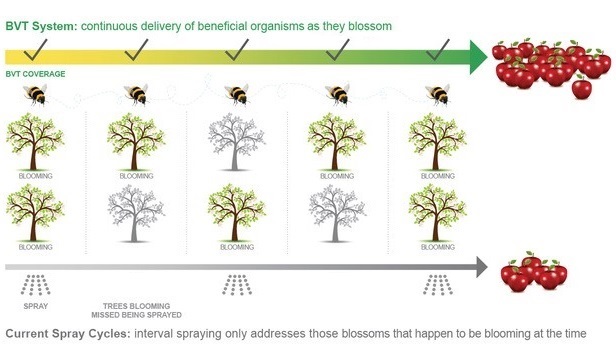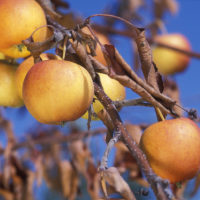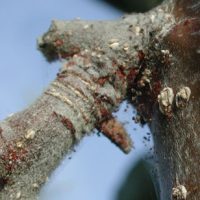A high-performance, natural solution for apple crop improvement
BVT’s comprehensive, stackable system uses commercially-reared bees to deliver highly targeted pest and disease control without harmful chemicals.
Increase your crop yield
Experience higher fruit yield in apples per acre
Reduce pesticide use
Reduce (or even eliminate) the number of pesticide sprayings to be performed
Continual delivery
Bees work every day carrying BVT active ingredients rather than interval spraying with pesticides
Increase fruit quality
Pollination enhances crop quality including shape and size
Common diseases and pests affecting apples
Apples are susceptible to a number of common diseases and pests that can wreak havoc on plant health, fruit yield and ultimately shelf life from orchard to plate. The BVT system has been specifically engineered to target these diseases and pests, dramatically improving crops all season long.
What is it?
Fire blight can rapidly spread and destroy many or all trees in apple orchards, especially when rainy and windy conditions are frequent during and after the blossoming period. Fire blight is caused by the bacterial pathogen Erwinia amylovora which also attacks pear trees and related ornamental plants.
How does it enter the plant?
In spring the bacteria ooze from overwintered cankers in apple branches and are dispersed in the orchard by rain and insects. The bacteria enter apple trees primarily through the blossoms after which the shoot tips wilt and appear in the form of a shepherd’s crook. The bacteria continue to migrate into the twigs and branches where new cankers form. Bacteria ooze from cankers and affected fruit. Entire branches can be killed and the trees often appear burnt and blighted in a matter of a few weeks.
Where does it come from?
Healthy trees can be infected by fire blight bacteria spreading from infected trees in the same orchard, or from other orchards or neglected trees in the region.
Additional Resources
- American Phytopathological Society
- The University of Minnesota Extension
- OMAFRA
- Michigan State University Video: Fire Blight – Shoot Blight Development
- Michigan State University Video: Early season build up of fire blight
What is it?
The European red mite is a major tree fruit pest attacking apples, stone fruits and pears. Overwintering eggs in the bark hatch during the bud and bloom stages. Young mites feed until mature and reproduce in newly opened leaves. Mites multiply rapidly in hot dry weather, but is slow under cool wet conditions.
How does it enter the plant?
Mites feeding on leaves cause injury to the tree by removing leaf tissue. The most serious injury occurs in early summer when trees are producing fruit buds for the following season. Moderate to heavily infested trees produce fewer and less vigorous fruit buds. Mites feeding on leaves also reduce the ability of leaves to manufacture enough food for desirable sizing of fruit. A characteristic brown foliage that, in severe cases, becomes bronze, results from heavy mite feeding. Left unchecked, mite populations can affect fruit color and result in premature fruit drop.
Where does it come from?
Mites are a very common pest and infest many crops and wild plants.
Additional Resources
The natural way to improve yields
BVT’s easy-to-use tray system introduces natural organic compounds to apple trees using commercially-reared bees.
As the bees pollinate an orchard, they leave behind the foundation for a season-long pest and disease management program that encourages even and progressive growth, resulting in a healthy, high yield harvest.

The BVT dispenser system contains the inoculant crop control as a part of the Vectorpak™ tray with Vectorite™ powder. The mixture allows the bees to effectively pick up the product on their way out of the hive.
Reduce bacteria dispersed by pollinators
The primary cause of Erwinia is through honeybees and other insects, birds, rain and wind – all of which can transmit the bacterium to susceptible tissue in an apple tree. The BVT system ensures each flower on an apple tree is delivered active ingredients to help combat this contagious disease. We use commercially-reared bees to accomplish this on a continual basis through their natural process of pollination, targeting each and every bloom in an orchard during the bloom period. An additional benefit is cross pollination. We harness other natural pollinators in the orchard, who help us out by carrying BVT active ingredients from one bloom to another.

Eliminate traditional spraying
The bloom period on an apple tree is four days, but trees bloom at different times over a much broader period of time. Hence interval spraying does not address all the blooms in an orchard. Another factor that hinders the effectiveness of spraying is the tree canopy which covers blossoms that hang low, making them inaccessible to the spray.
Start your demonstration today!
Contact one of our representatives to setup an on-site demonstration of the BVT system to experience the improvement it can have on your crop yield.








